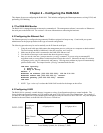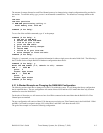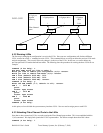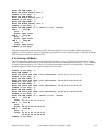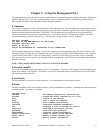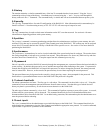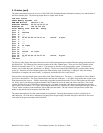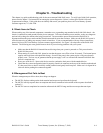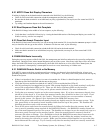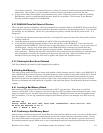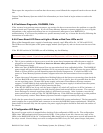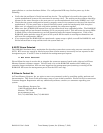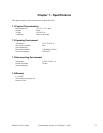5.5 history
The monitor maintains a volatile command history of the last 25 commands that have been entered. Using the ‘history’
command provides a listing of the history. Commands may be entered using the ‘<’ and ‘>’ keys to scroll through this
history or the unix-like ‘!’ commands. The command history is volatile and will not be maintained between power cycles.
5.6 ipconfig
The ‘ipconfig’ command allows for static IP configuration of the RAM-SAN. More information on this command may be
found in section 4.2. Note that setting an entry to 255.255.255.255 will cause rarp or bootp to be used.
5.7 log
The ‘log’ command may be used to obtain more information on the ECC error that occurred. See section 6.4 for more
information on diagnosing problems with system memory.
5.8 partition
The ‘partition’ command is a memory-partitioning tool that allows the administrator to configure system memory into sub-
sections (LUNs) that may be accessed by specific Fibre Channel ports in the RAM-SAN. The sections may also be assigned
access lists (LUN masks) that limit the visibility of the RAM-SAN to specific servers. See section 4.3 for more details on
partitioning the RAM-SAN.
5.9 performance
The ‘performance’ command may be used to view the bandwidth of the system back plane for each port. The monitor shows
the average bandwidth of each port over a period of one second. This performance view shows only DMA activity and does
not show other Fibre Channel activity. To stop the output from this command, press any key.
5.10 password
Since it is possible to access the RAM-SAN remotely through the management port, a password feature has been included for
system security. By default, this password is not set, and thus not requested when connecting to the system. If a password is
created, then all logins to the RAM-SAN will require this password. In order to change the password, the current password
must be entered first. However, on the console, the password may be set without requiring the current password.
The password feature may be bypassed on the console by simply pressing <enter> when prompted for the password. This
feature allows a system administrator access to the RAM-SAN if the password is forgotten.
5.11 reboot <hard/soft>
The reboot command has two forms. The first type is a soft reboot. The command is invoked with ‘reboot soft’. Using this
command will reset the management port and disconnect from all telnet sessions. Note that this type of reboot does not
destroy any data in system memory, so soft reboots are non-destructive to the RAM-SAN.
The other type of reboot command is ‘reboot hard’. This command will perform a power-on reset of the system. As a result,
all data stored in system memory will be destroyed. This command should only be used if all attached machines have
disconnected their drives from the RAM-SAN. As an added safety precaution, this command requires the administrator to re-
enter the password before rebooting.
5.12 reset <port>
The ‘reset’ command allows the administrator to reset individual ports on the RAM-SAN. This command should only be
needed under rare circumstances since the Fibre Channel ports handle the appropriate reset protocol. To issue this command,
a port number is specified as a parameter to the command.
RAM-SAN User’s Guide Texas Memory Systems, Inc. (February 7, 2003) 5-2





